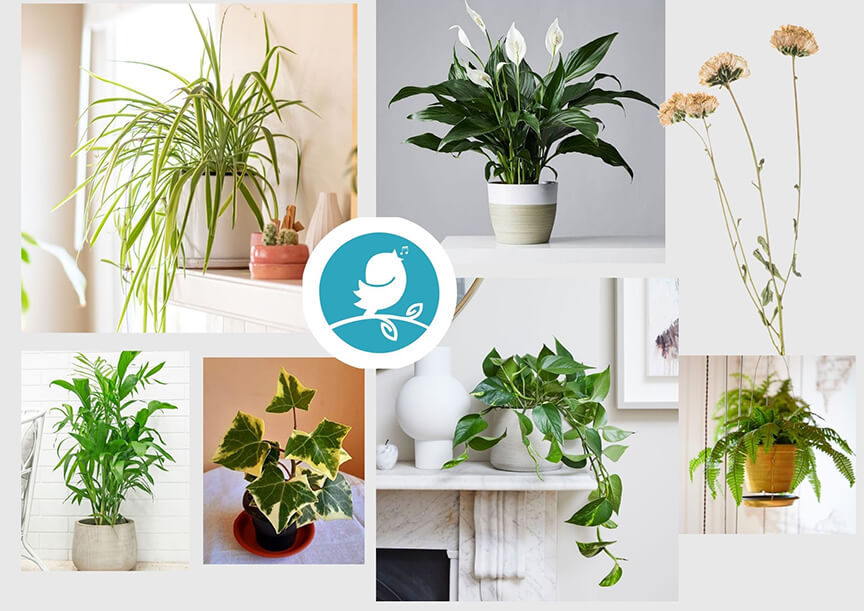Top 7 Air Purifying Plants for your Home
 30-May-2022
30-May-2022Getting “fresh air” sometimes seems an unachievable task despite our best efforts and hours spent cleaning. It's like facing a losing war against so many things affecting indoor air quality — cleaning products, formaldehyde, chemical flame retardants, and more.
Why not go for a simple, low-cost option instead of spending hundreds of rupees on air filters? Adding a few plants to your home is one of the most effective, natural ways to detoxify the air.
Several plant species, have natural air-filtering systems that can assist in the removal of pollutants and toxins from indoor air. Houseplants may absorb hazardous contaminants from the air, according to NASA experts, specially in enclosed spaces with little ventilation.
It's probably time for us to clear the air. Here are the top seven air-purifying houseplants:
English Ivy
The Hedera helix (English ivy) is an evergreen perennial. Woody vines are another name for these plants. English ivy can be used as a ground cover as it can spread horizontally and grows to a height of 8 inches. It is, however, a climber, thanks to its aerial rootlets, which enable it to reach heights of 80 feet. Although the plant may eventually produce small greenish blooms, it is primarily grown for its evergreen leaves. It can be considered as a foliar plant in this aspect. Spring is the optimum time to plant English ivy. It's a fast-growing, aggressive plant that's deemed invasive in a lot of places.
Boston Fern
The sword fern commonly known as the Boston fern (Nephrolepis exaltata), is a prominent fern species that is found in a variety of different tropical climates across the world. It's also a popular houseplant, because of its low sunlight requirements. This fern has year-round green foliage. Its sword-shaped, blue-green fronds with numerous small leaflets grow taller and arch as they mature. The Boston fern, like many other fern species, is a sluggish grower that grows best in the fall or spring. Smoking, cosmetics, resin paints, fragrances, air fresheners, and adhesives are all sources of formaldehyde, which is a frequent indoor air contaminant. The nose, eyes, and throat may become itchy. According to NASA, Boston Ferns are capable of absorbing a significant amount of formaldehyde from the atmosphere.
Read More: Top 7 Luxury Townships in Noida extension
Spider plant
The spider plant (Chlorophytum comosum) is regarded as one of the most adaptive and easy-to-grow houseplants. Except brown tips, this plant can thrive in a wide range of circumstances and has few challenges. Spiderettes, spider-like plants that dangle from the mother plant like spiders on a web, gave the spider plant its name. These spiderettes, which come in green or variegated variants, start off as little white blooms. The spider plant is one of the easiest plants to grow for air purification. Carbon monoxide, xylene, formaldehyde, and toluene are among the hazardous substances that can be removed from the air with the help of this plant. According to NASA, the spider plant is one of the top three types of houseplants for eliminating formaldehyde, a common home toxin found in manufactured wood items, plastic products, leather goods, adhesives, clothes, and other things.
Golden Pothos
In full light and mild weather duranta plants are simple to cultivate. They rapidly fill bare places in the garden and, in the areas where there are winter hardy, and can work as a privacy screen. This plant also eliminate contamination present in the air, providing a clean atmosphere.
You may cultivate the duranta as a long-blooming annual for the patio or even trim it into a topiary tree shape in a container garden. If you reside beyond the hardiness zones of the plant, you may still grow it as an annual in the ground. Plus, many gardeners have had success in bringing their containers indoors to continue growing their duranta as a winter houseplant.
Plant it after the last frost has passed in the spring, and enjoy the flowers until the cold weather comes in the fall.
Read More: Top 5 Famous Farm House Near Delhi NCR
Bamboo Palm
Bamboo palms (Chamaedorea seifrizii), despite their name, are a kind of palm in the Araceae family, not bamboo. They're great houseplants for adding a tropical vibe to any space. These tropical plants grow naturally as forest understory plants in Mexico and Central America. Bamboo Palm is also listed on NASA's air-purifying plants.
The bamboo palm, also known as the reed palm, grows to be approximately 5-7 feet tall and thrives in shaded interior areas. Humidity, indirect light, and a temperature of 65 to 80 degrees these conditions are ideal for bamboo palms. This plant can help in the elimination of formaldehyde, xylene, and toluene from the air.
Peace Lily
Closet plants, commonly known as peace lilies (Spathiphyllum), are a popular option for workplaces and homes. When it comes to indoor plants, peace lily plants are among the most simple to nurture. While caring for a peaceful lily plant is simple, appropriate growth conditions are still necessary. Peace lilies, like many other popular indoor plants, require medium to low light. The type of light you require will be determined by the appearance you want your peace lily plant to have. Peace lilies that receive more light produce more of the gorgeous white spathes and blooms, but peace lilies that receive less light bloom less and resemble a conventional foliage plant.
Along time research conducted by NASA found that peace lily also works as an air purifier. It eliminates formaldehyde, benzene, carbon monoxide from the atmosphere.
Go green with all these plants and create a healthy atmosphere around you by planting them. If you are searching for rented house in posh localities visit BivocalBirds.
Read More: Top 5 Natural Ways to Get Rid of Insects.



